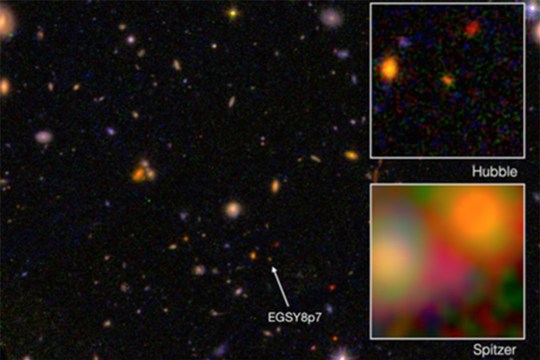The discovery of the “oldest galaxy ever found” could change universe evolution theories
At WIRED UK, James Temperton reports about the discovery of EGS8p7, the oldest, most-distant galaxy ever observed.
Astrophysicists have discovered the oldest, most-distant galaxy ever observed. EGS8p7 is just 500 million years younger than the universe itself, and its discovery could change current theories about the evolution of the early universe.
That’s because, according to our current models of theuniverse, EGS8p7 shouldn’t exist.
Spectographic analysis of the galaxy gives it a redshift of 8.68, making it older than the previous most distant galaxy, which has a redshift of 7.73.

Galaxy EGS8p7, as seen from the Hubble Space Telescope (wide and top right) and Spitzer Space Telescope (inset, bottom right), taken in infraredI. Labbé (Leiden University), NASA/ESA/JPL-Caltech
The first galaxies formed as soon as 328,000 years after the Big Bang, as protons and electrons joined to form non-charged hydrogen atoms.
Gravity forced these neutral atoms together into giant clouds that absorbed radiation emitted by young galaxies. It was only when galaxies later began to ionise hydrogen clouds that produced visible Lyman-alpha lines, because ionised hydrogen absorbs different wavelengths of radiation than neutral hydrogen.
The problem is that EGS8p7 should be too old for this to be the case. To explain the disparity, astronomers think it may have been unusually hot and bright, so much so that it quickly ionised the hydrogen cloud surrounding it. This would have made its Lyman-alpha line visible, despite it being less than half a billion years younger than the universe.
Read the about the rest of the findings at WIRED UK.
